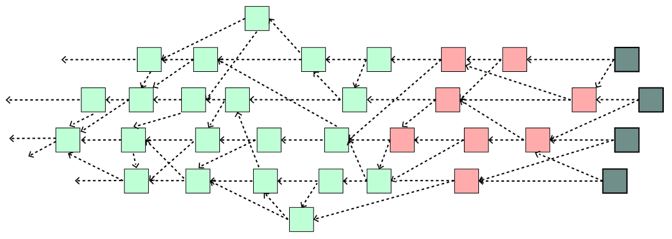The Possible Role of IOTA in Industry4.0
At the time this article was written, the cryptocurrency market showed major losses and is in a bear market now since 2018. The downfall affected all currencies more or less equally. Apart from this commonality, the currencies have very different potentials and use cases.
Bitcoin, for example, has already been touted as a candidate for a global currency. Meanwhile, the view is more of an asset, comparable to gold.
Besides the current weakness of the crypto market, the potentials of some coins are tremendous. This article lays focus on one particular cryptocurrency that was designed for IoT and Industry 4.0 purposes: IOTA.
The basics of IOTA
IOTA as collective term is, more precisely split into the cryptocurrency MIOTA and the IOTA Foundation, a nonprofit organization.
Since it was founded in 2015, IOTA has been able to enter into well-known partnerships. Examples include Volkswagen, Fujitsu, Telekom and Samsung.
Technically, it differentiates itself from most cryptocurrencies by its underlying technology. It is not blockchain but a directed acyclic graph (DAG).
In order to be able to send a transaction, two other transactions have to be validated. Each box in the picture below is a transaction. In addition, a proof of work needs to be completed.
A remarkable feature of the tangle is that it can operate offline and synchronize later. This is very important for IoT applications, where there is no guarantee for 100% connectivity. On the other hand, up to now, IOTA needs a centralized coordinator. However, this point of critique shall be removed midterm.

IOTA is specifically designed for secure communication and payment between two machines within the framework of the Internet of Things.
Now that we hopefully brought some light into the basics of IOTA, let us now have a look at a possible scenario in the context of Industry 4.0.
A possible scenario – The Challenge
In manufacturing, the key to a successful digital transformation towards Industry 4.0 are the machines.
More precisely, the machine builders.
Over the decades, countless MES companies, standardization organizations and initiatives have chewed their teeth in an attempt to open the closed, proprietary systems. Especially when it comes to software integration, the machine builders are paid well each time for opening their interfaces.
This will need to change, when conventional factories shall be transformed to smart factories.
But smart will not be possible without software. And good software needs a good foundation: The Shopfloor Software Architecture.
Nowadays, Microservice architectures are very hip. Indeed they fit very well to the distributed world of Industry 4.0, as I have shown in this article.
Nevertheless, how can the machine builders possibly be convinced to open up their API’s and interfaces? Even for free?
The answer is the industrial data market place.
A possible scenario – The Industrial Data Market Place
Industry 4.0 enthusiasts always speak of “machines talking to machines”. A possible scenario could be that they will do this over a market place.
But what exactly does that mean?
Talking machines make only sense, if a concrete value proposition is achieved. By the way, my personal interpretation goes much further, than “machines talking to machines”. It will be more like people, machines, sensors, systems and their digital twins talk to each other.
An example for the above mentioned value proposition could be the following:
Machine A recognizes that a necessary material is going empty soon and takes the appropriate steps, e.g. talking to a Material Manager Service
The value proposition in this case would be a lower downtime, and higher effectiveness. Another example, which goes much more into the direction of a data market place, is:
Each machine collects data about its state, faults, performance,… and provides or sells this data on an industrial data market place.
A derived use case could be that machine builders gain knowledge on how to operate their own machines the best way – and sell this to costumers. The experts who own this knowledge today are the manufacturers.
Furthermore, this example leads us to the core of the possible IOTA Industry 4.0 scenario. Just like data drives business in the consumer area, the principle will be the same for the industrial data market place. Google, Facebook and many others are experts in data-driven business models. However, who will be the Google of the shopfloor? Moreover, what are the differences in the industrial area?
Among others, there is one crucial difference. Consumers are, up to now, lax with their data, in terms of privacy and security. This will be essentially different in industrial environments. Data-driven industrial business models need bombproof transactions as a basis. In other words, they require some kind of (digital) ledger. Here comes IOTA into play. The Tangle assures secure transactions.
Another requirement is a low-latency, high-speed and low-cost mechanism for implementing payment transactions. IOTA with its zero transaction fees and scalable approach could also match here.
This article only scratched the surface of this very interesting topic. I plan to extent this to a small series.
![]() This article was written by Fabian Schmidt and originally appeared on the website Homo Digitalis. He is working as Head of Manufacturing Software Engineering. Dealing with Industrie 4.0 from the very beginning, he has a vast background in manufacturing, as well as IT. Fabian is writing the blog homo-digitalis.net and offers various services around Industry 4.0 and Digital Transformation.
This article was written by Fabian Schmidt and originally appeared on the website Homo Digitalis. He is working as Head of Manufacturing Software Engineering. Dealing with Industrie 4.0 from the very beginning, he has a vast background in manufacturing, as well as IT. Fabian is writing the blog homo-digitalis.net and offers various services around Industry 4.0 and Digital Transformation.
Sorry, the comment form is closed at this time.




Pingback: The Possible Role of IOTA in Industry4.0 | iotosphere - Internet of Things
Pingback: The Possible Role of IOTA in Industry4.0 – Digital Coin Owner